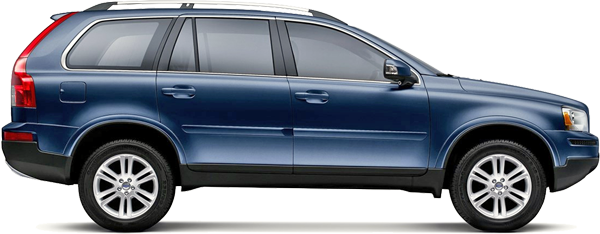The Comparative Analysis :
Audi Q7 3.6 FSI quattro tiptronic (09 - 10) vs. Volvo XC90 3.2 AWD Geartronic (5-seater) (06 - 09)
€ 51,800

€ 47,600

€ 51,800
Base Price ⓘBase price of a new vehicle with standard equipment in Germany at market launch.
€ 47,600
ⓘBase price of a new vehicle with standard equipment in Germany at market launch. Price Info
Vehicle Dimensions
The dimensions of these vehicles differ considerably. The Audi Q7 3.6 FSI is 11.1 inches longer, 3.3 inches wider and 1.9 inches lower than the Volvo XC90 3.2.
Audi Q7 3.6 FSI
Volvo XC90 3.2
68.4
78.1
85.7
70.2
74.7
83.1
78.1 in
Width
74.7 in
85.7 in
Width Incl. Mirrors
83.1 in
68.4 in
Height
70.2 in
118.2
200.4
112.5
189.3
200.4 in
Length
189.3 in
118.2 in
Wheelbase
112.5 in
Vehicle Weight
Audi Q7 3.6 FSI
Volvo XC90 3.2
5027 lb
Curb Weight
4542 lb
6460 lb
Gross Vehicle
Weight
Weight
5776 lb

Weight Difference:
485 lb
9.65 %

General
Audi Q7 3.6 FSI
Volvo XC90 3.2
4L
Generation
C
Sport Utility Vehicle
Car Body Style
Sport Utility Vehicle
Premium Unleaded
Fuel Type
Mid-Grade Unleaded

Permanent all-wheel drive (AWD)
Drivetrain
On-demand four-wheel drive (4WD) with automatic engagement

6-speed automatic transmission
Transmission
6-speed automatic transmission
Engine
Audi Q7 3.6 FSI
Volvo XC90 3.2
V6 gasoline engine (naturally aspirated engine)
Engine Type
Straight-six gasoline engine (naturally aspirated engine)
BHK
Engine Code
B6324S
4
Valves
4
6
Cylinders
6
3.6 L / 176 cu in
Displacement
3.2 L / 157 cu in
276 hp
at 6200 rpm
Power
235 hp
at 6200 rpm
Audi Q7 3.6 FSI
276 hp
235 hp
Volvo XC90 3.2
266 lb‑ft
at 2500 rpm
Max. Torque
236 lb‑ft
at 3200 rpm
Audi Q7 3.6 FSI
266 lb‑ft
236 lb‑ft
Volvo XC90 3.2
Performance
Audi Q7 3.6 FSI
Volvo XC90 3.2
140 mph
Maximum Speed
130 mph
8.5 sec
Acceleration 0 to 62 mph
9.5 sec
62 mph
62
mph
mph
387 ft
0.000 sec

Audi Q7 3.6 FSI
62 mph
62
mph
mph
433 ft
0.000 sec

Volvo XC90 3.2
▶ REPLAY
18.21 lb/hp
Weight-to-Power Ratio
19.33 lb/hp
Audi Q7 3.6 FSI
18.21 lb/hp
19.33 lb/hp
Volvo XC90 3.2
Fuel Economy / Emissions
Audi Q7 3.6 FSI
Volvo XC90 3.2
Fuel Economy
19 mpg
combined
20 mpg
Audi Q7 3.6 FSI
19 mpg
20 mpg
Volvo XC90 3.2
14 mpg
city
14 mpg
No data
highway
26 mpg
26.4 gal
Fuel Tank Capacity
21.1 gal
513 mi
Range
414 mi
Audi Q7 3.6 FSI
513 mi
414 mi
Volvo XC90 3.2
Environmental Impact
229.2 kWh
Total Energy Consumption
per 100 miles ⓘThe total energy consumption per 100 miles is the amount of energy consumed by a vehicle when burning fuel or using electricity per 100 miles (final energy), and the energy required to produce the appropriate amount of fuel or electricity (primary energy).
per 100 miles ⓘThe total energy consumption per 100 miles is the amount of energy consumed by a vehicle when burning fuel or using electricity per 100 miles (final energy), and the energy required to produce the appropriate amount of fuel or electricity (primary energy).
227.4 kWh
Audi Q7 3.6 FSI
229.2 kWh
227.4 kWh
Volvo XC90 3.2
Euro 4 III
Emission Standard
Euro 4 III
465 g/mi (NEFZ)
CO2 Emissions
462 g/mi (NEFZ)
Practical Convenience
Audi Q7 3.6 FSI
Volvo XC90 3.2
5
Doors
5
5
No. of Seats
5
1433 lb
Maximum Payload
1235 lb
21.9 cu ft
Trunk Volume
13.7 cu ft












57.6 cu ft
Cargo Volume (Seats Down)
52 cu ft




















